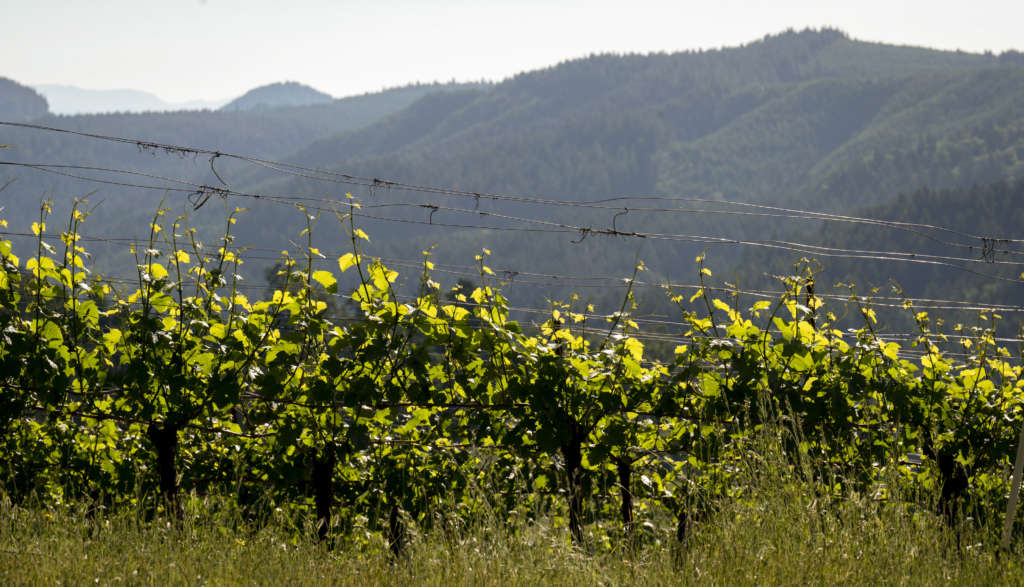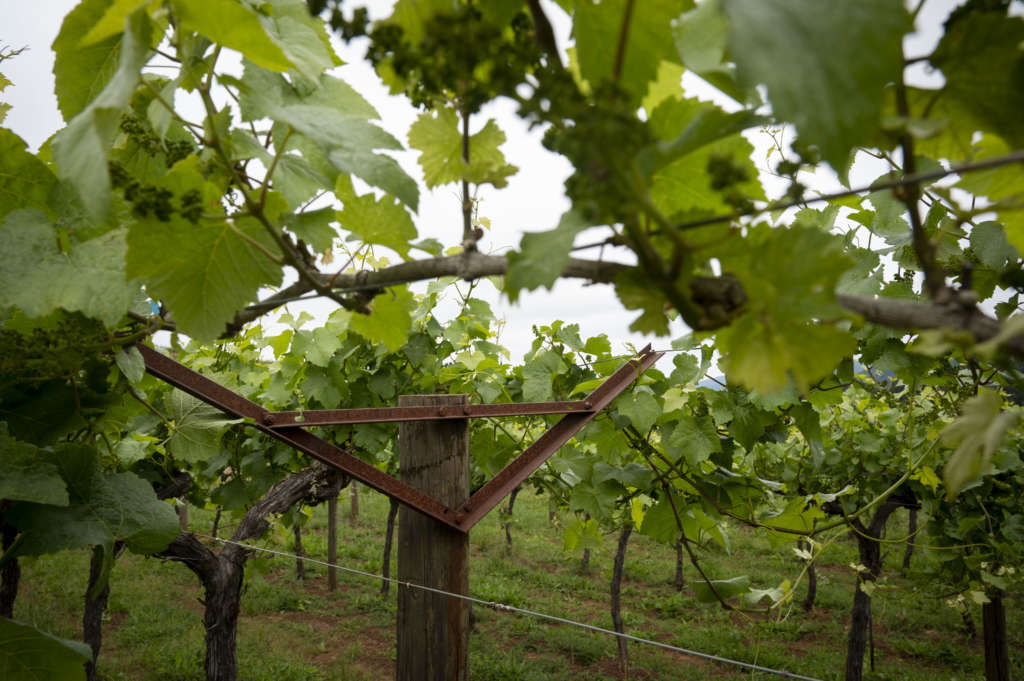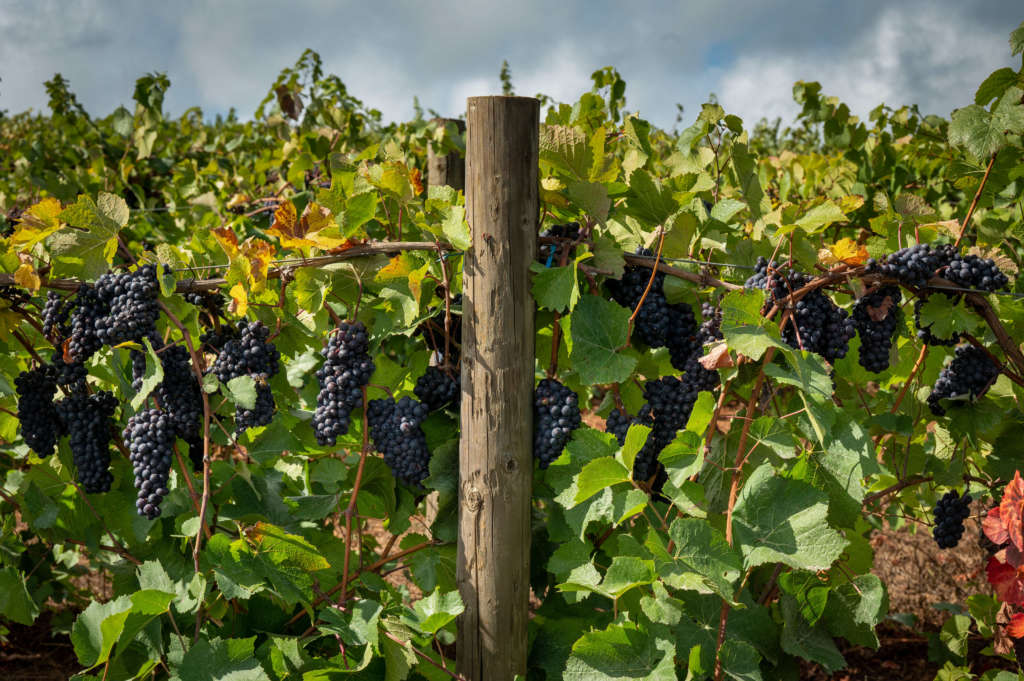The road up to King Estate cuts through some 465 acres of grapevines that, in this time right before harvest, are lush with green foilage and ripening fruit. Hidden by the leafy canopy are rows and rows of distinctly old-fangled trellis systems that stand sentry duty year-round to support the heavy vines, playing a key role in helping to produce plump, healthy and plentiful grapes.
One vineyard, four trellis systems
King Estate uses four different trellis systems. “Trellises are tools specific for use in the area being planted, not the varietal that is being planted,” explains King Estate Director of Viticulture Ray Nuclo. Before we get to why our viticulturists choose which system for different parts of the vineyard, let’s look at why we use trellises at all.
In some places – mostly hot, dry, windy regions – grapevines grow close to the ground, like shrubs. This method is used for smaller vines that aren’t at risk of toppling over. Vines are often trained in circles, like baskets, that preserve moisture and protect the grapes.
What do trellises do?
That’s not the case in opulent Oregon, where our heavy vines require some form of support to produce a healthy crop. Training vines onto a trellis helps light penetrate the canopy for photosynthesis to occur; reduces opportunity for disease to develop; promotes ripening; makes vines easier to prune and harvest, especially when harvesting by hand, which can also reduce labor costs; and keeps vines out of the way of cultivation and other vineyard operations.
At King Estate, the most common trellis is the Vertical Shoot Positioning system, or VSP. It is used across 78% of the planted acres on the estate. The other three are Geneva Double (GDC) at 13%, Lyre at 5% and Droop at 4%. The main difference between the systems is whether the vines are trained up or down on them.

VSP is the primary system
Vertical Shoot Positioning, or VSP, trains the vines upward, utilizing a number of fixed and movable wires to keep the canopy upright. VSP is good for areas of moderate to low fertility and is used in 78% of the vineyard. The vine shoots are trained upward in a vertical, narrow curtain with the fruiting zone below. The fruiting wire is typically 30 to 32 inches off the ground and may have two to three pairs of catch wires above it to train the shoot growth upward. The top wire can be about five to six feet high with the shoots trimmed at the top, giving the vineyard row a hedge-like appearance.
Rows are planted about eight feet apart. This trellis system is compatible with vineyard mechanization and can make some cultural practices easier such as leaf and shoot removal, cluster thinning and efficient spray coverage.

The GDC trellis
The next two systems, GDC and Lyre, are similar except Lyre vines are trained up and GDC are trained down. Both are double wire systems and tend to be used in fertile areas that are more productive per acre. Because white grapes often have higher yield potential, we use these systems to grow Pinot Gris at King Estate.
Geneva Double Curtain (GDC) is a double wire system that trains the vines downward. It is used in 13% of the vineyard. The system was developed at, and derives its name from, the Geneva–New York–Agriculture Experimental Station in the 1960s.
A high wire system, GDC is generally used in deeper, lower lying areas where the soils are more fertile, producing more vegetation, or leaves, at the expense of the fruit. One way to establish a balance between fruiting and vegetation growth is with the split, or divided, trellises where a single vine is trained onto two hanging curtains, also called canopies, per row. Training the growth downward reduces the vigor of the shoots. The system can result in yields that are 50% higher than for single curtain systems. GDC’s special advantage is that grape shoots are allowed to grow downwards requiring less canopy management compared to VSP and Lyre systems.
GDC systems are recognizable by the cross arms, three-and-a half to four feet in width, that separate the support wires. Rows are 11 feet apart, from center row to center row. GDC is less suited to machine picking and other mechanized vineyard operations so may be used less in the future.

Lyre has a distinctive look
Lyre is a double wire system, also known as a U-shaped trellis, that trains the vines upward and is used in 5% of the vineyard. The Lyre system was developed in the 1980s in the Bordeaux region of France.
Training the canopy in this fashion is used as a defense against mildew by exposing grapes to more wind and sun. Typically this trellis system is used in high-yielding areas. As the vines grow, crews move the wires up to “catch” the growing shoots as they grow outside of the trellis. Along with Pinot Gris, we grow a little Gewürztraminer on the Lyre trellis. One advantage the Lyre system has over the GDC is that the fruit is under the canopy as opposed to on top, leading to less sun exposure. That lowers the risk of sun burn or excessive accumulation of phenolic compounds which are less desirable in grapes for white wine production like Pinot Gris.

Last but not least, the Droop
Droop, or Single High Wire, is, as the name suggests, a single wire system, but in this case the vines are trained downward. It is used in 4% of the vineyard.
The Droop system is much like GDC except GDC is double wire and Droop is single. Droop was in fashion early on, perhaps because it was commonly used in California which produced many of Oregon’s wine pioneers. But in the 1990s the system took a back seat to VSP and remains less popular.
The only grapes grown on our Droop trellises are Pinot Noir and, whether due to the trellis system or some other factor, we like the quality of fruit that comes from the Droop blocks. These grapes often find their way into our premium Domaine Pinot Noir.
